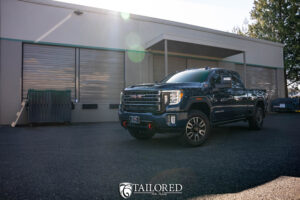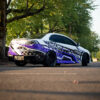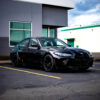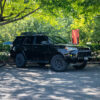Paint Protection Film (PPF) has come a long way since its early days as a basic protective layer. Originally designed to prevent damage in extreme conditions, today’s PPF technology offers superior durability, self-healing properties, and hydrophobic coatings that provide long-lasting protection for vehicles. At Tailored Auto Styling, we specialize in high-quality PPF installation in Portland, OR, ensuring your vehicle remains in pristine condition.

The Early Days of PPF
PPF was initially developed for military applications, particularly to protect helicopter rotor blades and aircraft surfaces from debris and harsh environments. The United States military, specifically during the Vietnam War, faced a significant challenge with helicopters sustaining damage from flying debris and shrapnel. To mitigate these issues, engineers developed a clear, urethane-based protective film that could be applied to the leading edges of rotor blades, increasing their lifespan and preventing costly replacements.
These early films were thick, rigid, and primarily designed for functionality rather than aesthetics. While they provided much-needed protection against impact damage, they were not optimized for visual clarity, making them impractical for consumer vehicles at the time.
Transition to the Automotive Industry
As the benefits of protective films became more evident, automotive manufacturers and aftermarket specialists began experimenting with ways to apply the technology to vehicles. The goal was to create a film that could protect vehicle exteriors from rock chips, scratches, and environmental damage while remaining clear and flexible enough to conform to complex vehicle shapes.
During the 1980s and 1990s, high-performance and luxury car owners started seeking solutions to keep their vehicles looking pristine. Paint protection film manufacturers saw an opportunity to introduce a more refined version of the military-grade product, one that could offer both durability and near-invisibility.
However, early versions of PPF still had significant limitations:
- The films had a noticeable yellow tint over time due to exposure to UV rays.
- The adhesive technology was not as advanced, leading to peeling and bubbling after prolonged exposure to the elements.
- The texture was rough, often dulling the car’s finish rather than enhancing it.
Despite these drawbacks, PPF gained popularity among professional drivers, race car teams, and exotic car enthusiasts who were willing to prioritize protection over aesthetics.
The 2000s: A Turning Point for PPF Technology
The early 2000s saw rapid advancements in PPF technology. Manufacturers refined the chemical composition of urethane films, creating a clearer, more flexible, and longer-lasting solution. New adhesive formulas were introduced, allowing the film to bond better to painted surfaces without trapping air bubbles or lifting at the edges.
Perhaps the most significant breakthrough in this era was the introduction of self-healing properties. By incorporating elastomeric polymers, manufacturers developed films that could automatically repair minor scratches and swirl marks when exposed to heat. This innovation significantly improved the appeal of PPF for mainstream consumers, as it meant fewer maintenance concerns and longer-lasting protection.
As the demand for PPF grew, installation techniques also improved. The introduction of computer-cut templates allowed installers to apply PPF with precision, reducing waste and ensuring a perfect fit for every vehicle model. The industry saw a rise in professional PPF installers who specialized in custom coverage options, including full-body wraps and high-impact zone protection.
Present-Day PPF: A Superior Product
Today’s paint protection films are virtually indistinguishable from factory paint. PPF manufacturers now integrate cutting-edge technologies, including nanotechnology, ceramic coatings, and hydrophobic treatments, to improve performance. These enhancements ensure that modern PPF provides not only protection but also added shine and ease of maintenance.
Types of Modern PPF
Depending on your needs, there are various PPF options available:
- Glossy PPF: Enhances the natural shine of your vehicle’s paint, making it appear even more polished and sleek.
- Matte PPF: A perfect choice for those who want a subtle, satin-like finish on their vehicles.
- Colored & Custom PPF: Some manufacturers now offer PPF in different colors or even with unique patterns, combining protection with personalization.
- Self-Healing PPF: Automatically repairs minor scratches and swirl marks when exposed to heat, keeping your car looking flawless.
- Hydrophobic PPF: Features water-repelling properties that make it easier to clean and maintain.
The Real-World Benefits of PPF
- Protection Against Road Debris – In urban and highway driving, loose gravel, small rocks, and road debris can cause significant paint damage. PPF acts as an invisible shield, absorbing impacts and preventing chips.
- UV & Oxidation Protection – PPF provides a strong barrier against harmful UV rays that can cause paint to fade over time.
- Scratch & Swirl Resistance – Whether from washing, accidental scrapes, or minor impacts, PPF helps protect your paintwork from unsightly marks.
- Easier Maintenance – With hydrophobic properties, PPF reduces dirt buildup and makes washing your car easier and more efficient.
- Enhances Resale Value – A vehicle with well-maintained, original paint protected by PPF often has a higher resale value than one with visible chips, scratches, and oxidation.
Industry Trends & Innovations in PPF
As PPF technology continues to evolve, we’re seeing even more advancements on the horizon. Ceramic-infused PPF is now available, combining the best of PPF with the durability and hydrophobic properties of ceramic coatings. Additionally, self-healing films are becoming more efficient, with faster response times to heat activation.
Future innovations include smart PPF coatings, which could adapt to temperature changes and environmental conditions, offering enhanced protection in different climates. Some manufacturers are even developing self-repairing PPF that can heal from deeper scratches and dents, taking durability to a whole new level.
Frequently Asked Questions (FAQ)
How long does PPF last?
With proper care, high-quality PPF can last up to 10 years or more. Longevity depends on factors such as exposure to harsh elements, maintenance, and the quality of installation.
Will PPF affect my car’s paint color?
No. Modern PPF is virtually invisible and enhances the natural color and gloss of your paint without altering it.
Can PPF be removed without damaging my car?
Yes! Professionally installed PPF can be removed safely without damaging your vehicle’s paint. It’s always best to have it removed by an expert to avoid any residue or adhesion issues.
How do I maintain my car after getting PPF?
It’s recommended to wash your car regularly using a pH-neutral shampoo and avoid abrasive cleaning tools. Applying ceramic coatings over PPF can also enhance longevity and protection.
Does PPF provide protection against scratches and dents?
PPF is designed to protect against rock chips, minor scratches, and environmental contaminants. While it won’t prevent deep dents from heavy impacts, it does significantly reduce the chances of surface damage.
Get the Best PPF Installation in Portland, OR
At Tailored Auto Styling, we specialize in professional PPF installation using industry-leading materials to protect your vehicle’s exterior. Whether you want full-body coverage or protection for high-impact areas, our expert team ensures a perfect, seamless fit every time.
📍 Visit us at: 2330 SE Clatsop St, Portland, OR 97202, US
📞 Ready to protect your investment? Contact us today for a consultation!




